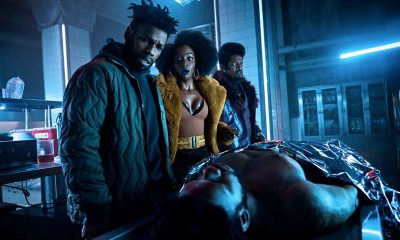Movies and TV
An In-Depth Look at the Hidden Meaning and Symbolism in “Blink Twice”
In “Blink Twice,” unsuspecting women are flown to a tropical island and abused by some very wealthy men. This premise is clearly inspired by Jeffrey Epstein’s infamous island, which the world’s most powerful people visited. While the movie appears to be “exposing” what happens in these gatherings, its symbolism gives the story a different meaning. It is rather twisted.
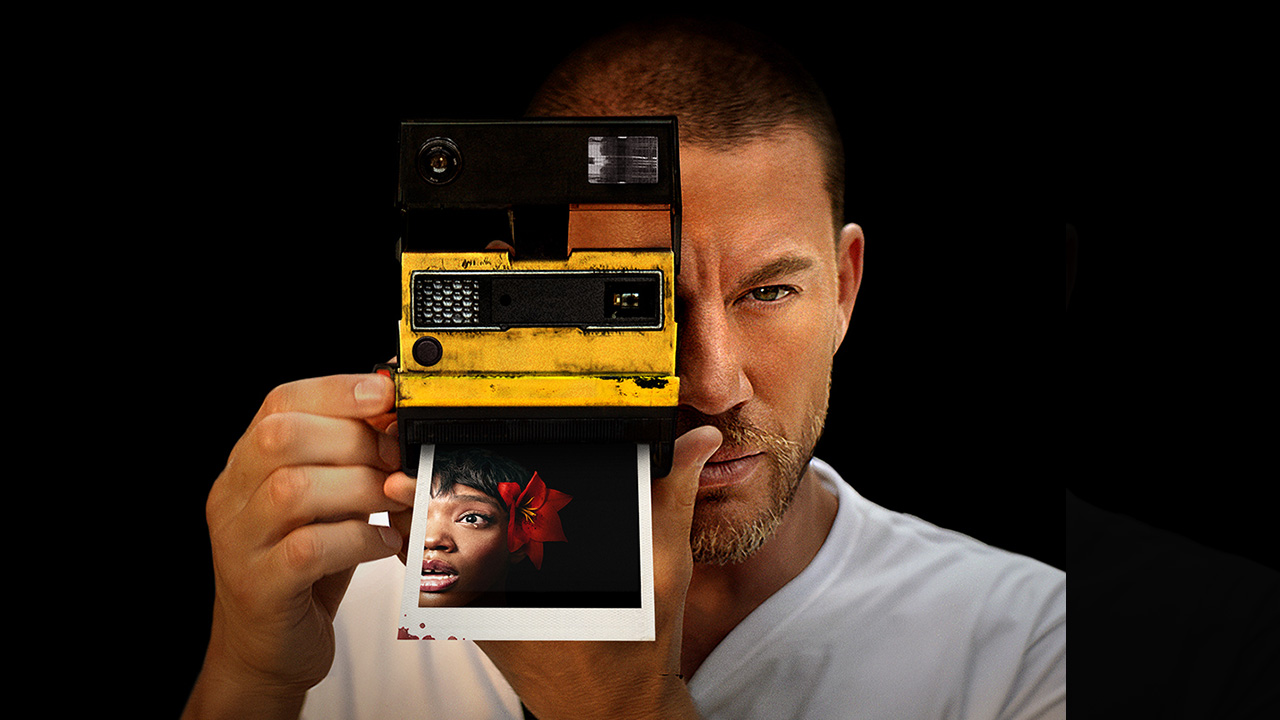
Warning: Moutnainous spoilers ahead!
Blink Twice begins with a “trigger warning,” stating that it is a “psychological thriller about the abuse of power” and that it contains “sexual violence.” While this message appears to be well-meaning, it also gives off a strange feeling that it promises “sexual violence” to the weirdos turned on by it.
This bivalence sums up the entire movie. While it appears to say one thing, it actually says the opposite.
To prove this fact, one only needs to look at the movie’s original name: Pussy Island. While the movie is believed to “expose” rich and powerful people abusing people in remote islands, the pornographic flavor of the original title turns it into a twisted, voyeuristic experience.
Inspired by the horrific stories of Epstein Island (although the media actively censors the rampant pedophilia that happened there), Blink Twice reframes, distorts, and, in a perverted way, glamorizes. The “sexual violence” scenes are padded with long minutes of “humor” which end up turning everything into a joke. Meanwhile, the underground sex ring of the elite is turned into a “feminist” narrative, where women killing a bunch of men solves everything. Of course, none of this reflects real life, where lots of women actively facilitate and even participate in the abuse.
Blink Twice does not expose or even comment on the elite drugging and raping sex slaves, including minors. Because, in the end, it is a Hollywood movie. Do you think Hollywood would do that to itself? As we’ll see, this movie’s “moral of the story” is not about overthrowing this system but perpetuating it – but with a pseudo-feminist angle.
Everything about Blink Twice is weird, disingenuous, and profoundly disconnected from reality. It is how Hollywood people would portray what Hollywood people do in places like Epstein Island. Appropriately enough, the movie is the directorial debut of Zoë Kravitz – the daughter of musician Lenny Kravitz and actress Lisa Bonet. She’s a product of Hollywood, and she’s been inside that system since birth.

Zoë Kravitz parades at MET Galas (the ultimate gathering of occult elite pawns) nearly every year. Here, she’s wearing a mask often seen at the elite’s masquerade parties.
Along with film writer E.T. Feigenbaum, Kravitz crafted a movie that turns the elite’s disgusting obsessions into “entertainment.” More importantly, the movie symbolically portrays the events as a “sacrifice” necessary for the protagonist to obtain what she truly desires.
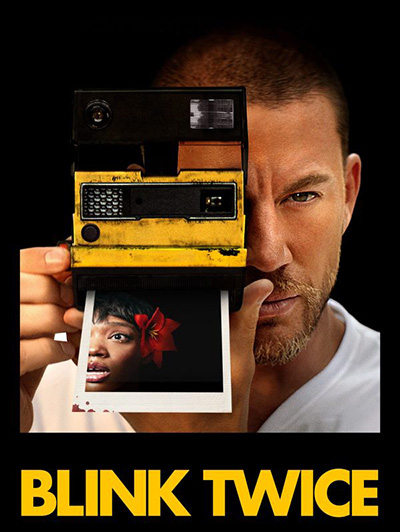
The movie’s poster contains not one but two one-eye signs. The message: This is a movie by the elite about the elite.
While the movie’s story is relatively straightforward, semi-hidden references and symbolism add a layer of meaning—and they are rather disturbing. It is about trauma-based mind control.
Here’s a look at the major themes of the movie.
Premonitions
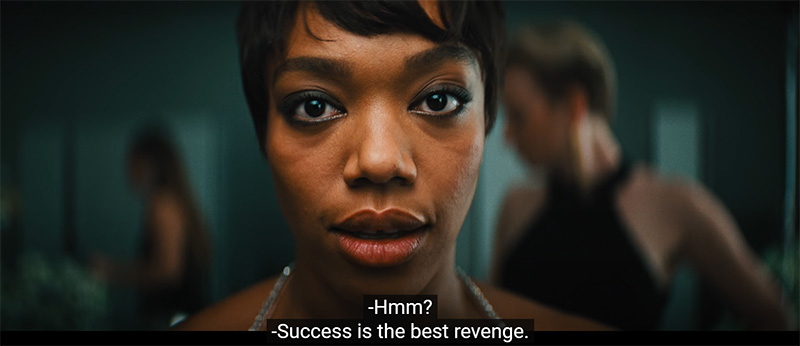
Frida repeats the movie’s motto to herself. It will take a disturbing meaning.
Blink Twice‘s protagonist is Frida, a struggling cocktail waitress attempting to launch a nail business. In the movie’s first scene, she watches a video of Slater King, a tech billionaire who was accused of “abuse of power” and “regrettable behavior.”
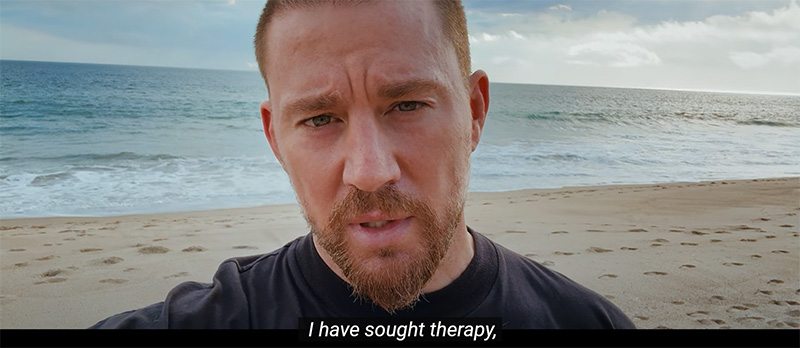
Frida watches Slater King apologizing and saying that he “sought therapy.” As we’ll see, his “therapy” is related to trauma-based mind control. Also, we learn that he bought a whole island to “heal.”

Meanwhile, Frida is sitting on the toilet as we briefly see a book called “Success is the Best Revenge” by Vanessa Maxwell, a fictional author.
Major spoiler: Frida ends up on Slater’s island and gets abused. This book’s title hints at the movie’s moral of the story: It is not about denouncing evil and bringing it down; it is about taking Slater’s place.
Notice that the author’s last name is Maxwell. Is it a coincidence that she shares a last name with Ghislaine Maxwell – Jeffrey Epstein’s right-hand woman who coordinated his sex trafficking? The ultimate goal is to become her, not bring down the system.
This message is further cemented in the following scene as we see Frida working to the tune of B.B. King’s song Payin’ the Cost to be the Boss. This line sums up the movie: Frida sacrifices herself to become the head handler.
Before that happens, she has to go through a lot of trauma. In fact, she already did. She was abused on Slater’s island in the past but she has no recollection of it.
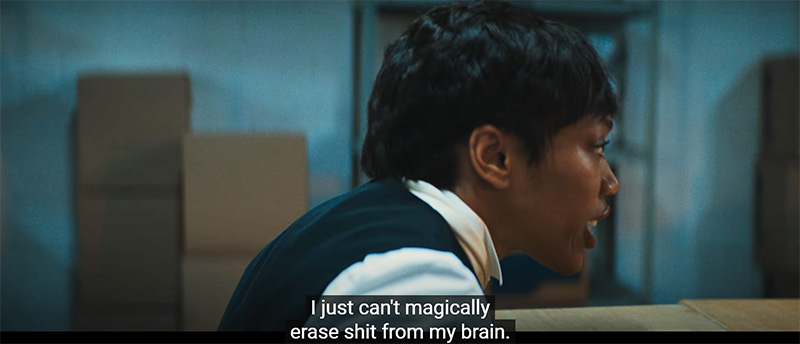
As she gets prepared for work, she ironically says that “she can’t magically erase sh*t from her brain.” Her memory was erased in the past.
In the movie’s first act, Frida works as a waitress at a special event hosted by Slater King’s tech company. Everything at the event is occult elite madness, but none of this is obvious to the casual viewer.

The event is hosted by Saul Williams, who is wearing a dress because they love black men wearing dresses. Behind him is Michaelangelo’s Pieta, which depicts the Virgin Mary holding Jesus. We’ll later see how this sculpture is symbolic.

Every single thing at this event is highly symbolic.
First, everything is white, red, and black. As seen in previous articles, those colors have heavy ritualistic meanings. Later, we’ll see that these colors are used to tell an occult narrative.
Second, there’s a giant ominous door in the background. Its name? Gates of Hell by French sculptor Auguste Rodin.
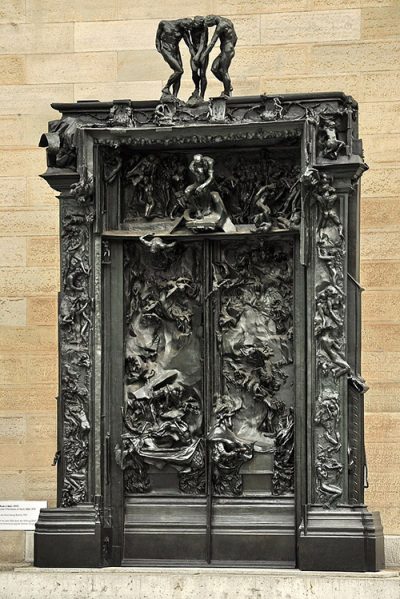
One of the several variations of Gates of Hell inspired by Dante’s Inferno and its warning: “Abandon hope all ye who enter here.”
Most of the sculptures seen throughout the movie are from Rodin’s Gates of Hell collection, which includes The Thinking Man, which stands next to it at the event. Do these sculptures subtly indicate that this occult elite gathering is a “gate to hell?” Is it implying that they’re Satanists?
After the event, Frida and her friend Jesse wear sexy dresses to get Slater’s attention. I’m not saying they’re golddiggers, but … yeah.
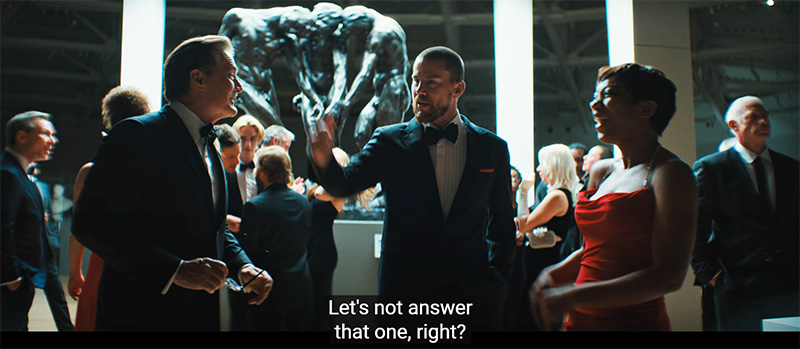
Frida talks with Slater and his “therapist,” Rich Stein.
Frida is wearing a bright red dress. In occult rituals, it is the color of sacrifice. She will be abused by both of them later. However, according to the movie’s logic, she has to “pay the cost to be the boss.” Behind them is another Rodin sculpture from his Gates of Hell collection. Named The Three Shades, it represents three damned souls connected. Are the three characters in the foreground three damned souls as well?
After partying with Slater and his friends, Frida is invited to board his private jet and travel to his island. She immediately agrees because the dude is rich.

On the island, all the victims are given white dresses. In occult rituals, white is the color of purity and virginity. It is worn by the “initiates” before their transformation.
At first, the girls are more than happy to be there as they are offered unlimited food, drinks, and drugs.
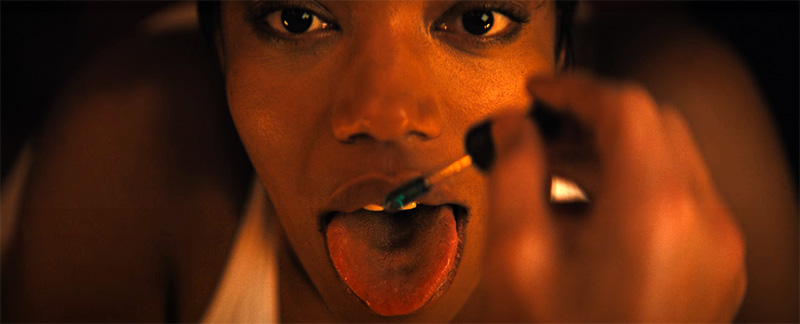
In a scene reminiscent of the Eucharist, Slater gives Frida MDNA. It’s their “communion.”
After some partying, Frida notices some clues indicating that something wrong is happening: The girls are getting abused at night. However, they do not recall it in the morning because their memory gets erased. So they wake up happy and refreshed (albeit hungover), as if nothing happened.
Some might ask: Wouldn’t they feel sore in some places even if their memories were erased? The answer is yes, but let’s not poke through plot holes because we’ll be here all day. In any case, this movie is not about an airtight plot but about messages through symbolism.
Color Codes
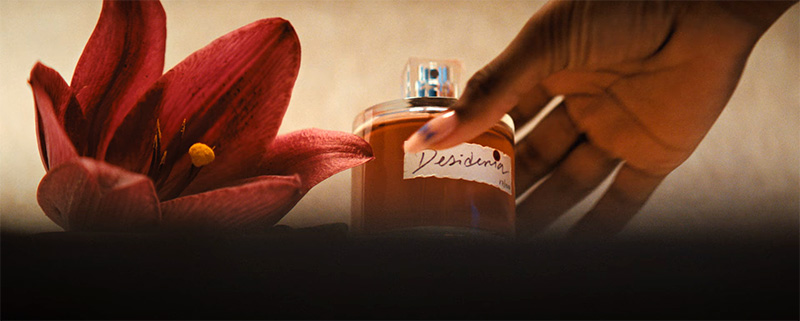
The victims’ memories are erased using a perfume called Desideria (meaning desire). It is made from a red flower only found on that island.
Throughout the movie, the color red is associated with trauma, sacrifice, mind control, and memory loss.

Slater’s assistant, Stacy, is the Ghislaine Maxwell of the group. She’s the woman who facilitates the abuse by putting the victims at ease. She’s often dressed in bright red to indicate she’s part of the system.
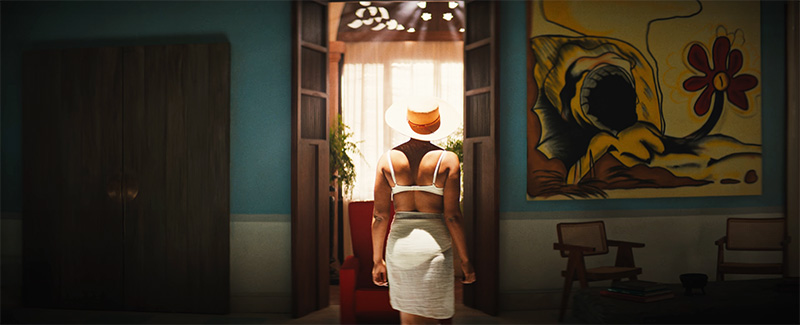
As Frida explores the island, she walks by a creepy painting depicting victims’ memory loss due to the red flower.
As observed in numerous past articles, the occult elite loves “art” that celebrates their sick obsessions. They yearn for their evil deeds to be out in the open.

When John Podesta was Hilary Clinton’s campaign advisor, there was a painting depicting cannibalism in his office. Yes, it is 100% authentic, and even NBC News had to address it.

Guests on the island are given parting gifts inside a bright red bag. Inside the bag is the Desideria perfume so they can keep abusing people and erasing their memories when they come back home.

A Mexican maid on the island called Frida “Red Rabbit” because she had red rabbits on her fingernails the first time she was there.
As seen in previous articles, the White Rabbit symbol is significant in mind control. Inspired by Alice in Wonderland, victims are told to follow the White Rabbit towards the looking glass—a symbol of dissociation. The white rabbit is red in the movie because that color is associated with memory loss.

A painting depicts rabbits and people locked in cages. It’s all mind-control symbolism.
While red is associated with the erasure of memories, yellow represents the opposite: Making and recovering memories. This concept is subtly peppered throughout the movie.

Privileged guests “make memories” by taking pictures using a yellow Polaroid camera throughout their stay. Here, Christian Slater is wearing a yellow towel while doing the opposite of erasing memories.

The antidote to the memory loss perfume is venom from yellow lash vipers. Yellow equals truth and regaining memory.

Jess is draped in yellow as she starts realizing the dark truth about the island.

After Jess is killed because she knows too much, the other girls do not recall her. Her yellow lighter is proof that she existed.
The dualistic back and forth between the colors red and yellow mirrors the mind control slave’s back and forth between trauma and dissociation. And those who go through this often end up perpetuating it.
The Cycle of Trauma
As seen in previous articles, MK handlers are often mind-control victims themselves. As the movie progresses, we learn that Slater is a victim of trauma and memory loss himself. While discussing with Frida about the uselessness of therapy, he says:
– But I agree with you on the whole talk therapy thing. That’s not really what I’m into. Rich is more of s trauma therapist. You know, he specializes in memory loss.
– What can’t you remember?
– Pretty much anything before 10. So I imagine it was probably pretty bad.
– Why would you want to remember? I’d pay to forget.
– Maybe you’re right. Maybe forgetting is a gift.
We later learn that Slater was abused as a child by his tennis instructor causing him to repress memories. Now he’s doing it to other people.
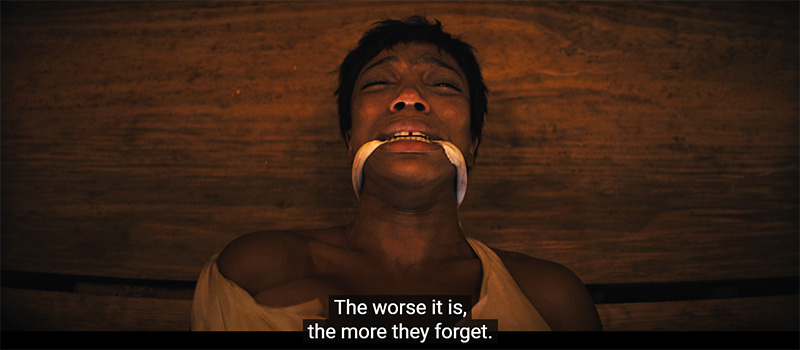
As he’s about to rape Frida, Slater tells his “therapist” that the more intense the trauma, the more severe the memory loss. This is Monarch mind control 101.
Slater went from victim to abuser. Frida will go on the same path. And the movie will frame this as a “happy ending.”
After consuming viper venom, Frida and the other women realized what happened to them and engaged in a bloody revolt. Opposing women versus straight white men, the movie frames it as a “feminist” thing. But that’s typical Hollywood hypocrisy. This is not about women banding together but about Frida “paying the cost to be the boss.”
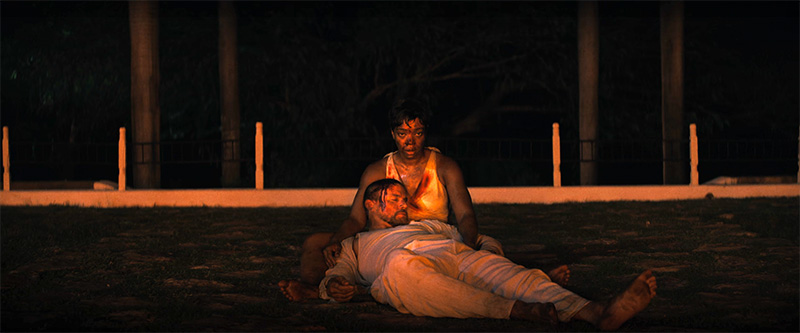
After the revolt, nearly everyone is dead except Frida and Slater because she purposely spared his life.
Notice how the characters are positioned in the scene above.

In the next scene, we see the Pieta sculpture again. Slater is Frida’s Jesus Christ.
In the movie’s final scene, we’re at another King-Tech event, as if nothing changed. However, there’s one massive change.

Frida is now the CEO of King-Tech, and Slater is her obedient, mind-controlled slave.
Frida has turned into the MK handler, using the memory-erasing perfume to control Slater. In this scene, she is also wearing black. In occult rituals, black is always the final color—it represents the complete transformation of the initiate into the “dark side.”
In the end, nothing has changed, and the system remains intact. The only difference is that the slave has become the handler.
In Conclusion
Frida did not expose the elite’s wrongdoings nor denounce them to the world. Instead, she used their tools to gain power, wealth, and influence. This is the true message of Blink Twice: Good did not prevail. Evil did. And people will root for it because “diversity” is doing it now.
In the end, Blink Twice is pure Hollywood hypocrisy. Instead of exposing evil, it normalizes it, turns it into entertainment, and causes viewers to root for its perpetuation. What else do you expect from people who titled a movie inspired by Epstein’s pedophilic hellhole the sexy name of Pussy Island?
- Hmm 🤔
- Donald Trump attends WEF conference in Davos (January 2020)
- 100% Proof Our Government is Hiding Nephilim Bodies & Are Trying to Bring Back Nimrod/Gilgamesh. Could Nimrod be the Beast of Revelation 17:8-11?
- Tesla's Elon Musk: We're 'Summoning the Demon' with Artificial Intelligence
- Lindsay Mills : Are you aware of occult symbolism in Her pictures..?!?
- LA Fire Attack Map is identical to the LA Smart City Rail Map
- Birds of a feather flock together …
Get an e-mail notification as soon as a new article is published on The Vigilant Citizen.
-

 Movies and TV2 months ago
Movies and TV2 months agoAdrenochrome and Ritual Humiliation: The True Meaning of the Movie “The Substance”
-

 Pics of the Month3 months ago
Pics of the Month3 months agoSymbolic Pics of the Month 10/24
-

 Latest News2 months ago
Latest News2 months agoKamala’s Campaign Was Objectively the Worst in Recent History
-
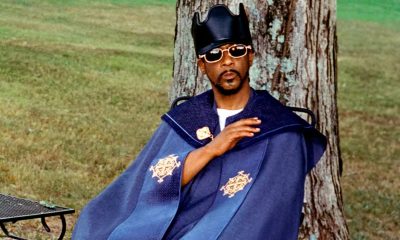
 Pics of the Month2 months ago
Pics of the Month2 months agoSymbolic Pics of the Month 12/24
-

 Latest News2 months ago
Latest News2 months agoWas the Jake Paul vs Mike Tyson Fight a Humiliation Ritual?
-

 Latest News3 months ago
Latest News3 months agoAn “Urban Opera” in Toulouse Using Massive Machines is Denounced as a Satanic Ritual
-

 Movies and TV1 month ago
Movies and TV1 month agoThe Hidden Meaning of “Smile 2”: It’s About Monarch Mind Control
-

 Latest News1 month ago
Latest News1 month agoIt Was Bound to Happen: Jay-Z Accused of Abusing a 13-Year-Old Girl








